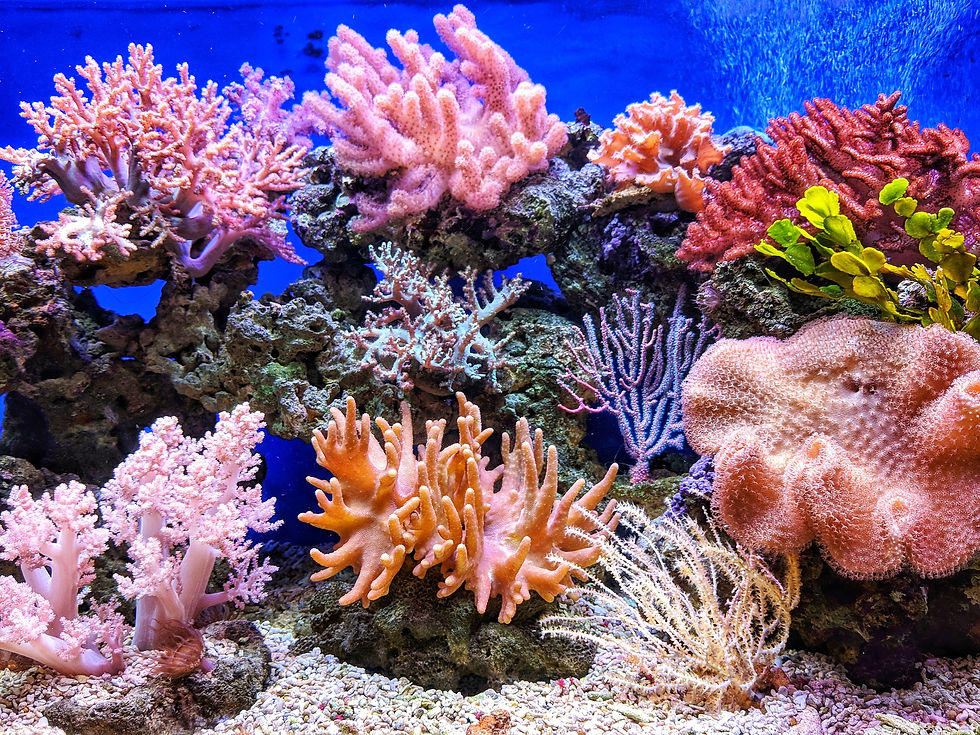Brands Transforming Ocean Plastic Into Beautiful Accessories
- Hannah Duffy

- Jun 26, 2021
- 3 min read
Updated: Aug 16, 2021
Our beautiful oceans are full to the brim with an abundance of plastic waste. Inspired by this, social entrepreneurs are looking for a solution in the shape of ocean plastic accessories. A growing number of eco-conscious brands are using waste collected from the ocean to create wearable and sustainable pieces.
Balenciaga X Shahar Livne
Conceptual material designer Shahar Livne, collaborated with Balenciaga to create a range of ocean plastic jewellery for the brand’s latest collection “Afterworld: Age Of Tomorrow”.
Using ocean sourced plastic waste retrieved and cleaned by Oceanworks, the fall 2021 collection, consists of rings, bangles and earrings. The plastic waste is then combined with calcium carbonate – a residue of the marble industry. Indeed – combining two waste products – contributes to the creation of an even more sustainable product.
Inspired by Livne’s metamorphism project, she and Balenciaga hoped for the accessories to have a fossilised, dystopian look. The project considers the future of plastic waste and how it could blend with natural matters become an entirely new resource. Undoubtedly they have achieved that.
The overall look of the ocean plastic accessories seems poles apart from when their components were found in the oceans. And yet even further from when they were functional plastic products.
Nurdle in the Rough
Using washed up plastics and recycled precious metals founder of ‘Nurdle In the Rough’, Kat Crabill, creates hand-crafted jewellery. Named after plastic pellets that find their way into the oceans, plastic pollutants lie at the heart of her brand.
Plastic pollution has hit Kamilo Beach on the Kau coastline of Hawaii harder than most areas. Despite this, it is Crabill’s goldmine. Household and fishing industry waste are the main culprits with bottle caps, toothbrushes, rope, and catch crates to name a few.
Through hand polishing the post-consumer plastics, she transforms ocean plastics into gemstones. The wearable art she creates turns one person’s trash into another person’s treasure resembling jade or quartz. She highlights how ocean plastic accessories don’t have to look like something pulled straight from the ocean.
Patagonia X Bureo
Start-up brand Bureo are creating their own sustainable material made entirely from recycled fishing nets, arguably the most harmful form of plastic pollution. The discarded fishing nets are sorted and cleaned once collected, ready to be recycled into the NetPlus material.
Owing to this process, companies are provided with a sustainable alternative to using virgin plastic. Patagonia is one of those companies. To replace the virgin plastic found in every hat brim, Patagonia is using Bureo’s NetPlus as their stiffeners. Therefore entirely reimagining the traditional construction of their hats.
As a result of this they’ve repurposed 35 tons of discarded nets from our oceans in the first year alone. Additionally, through working with local communities since 2013, Bureo has recovered over 600,000kg of waste from 50 fisheries in South America.
Not only is it the final product that has a lasting impact, but the waste collections have financed community projects. Consequently supporting the South American fishing communities in making their waste management more sustainable.
So, what’s the point in making ocean plastic accessories?
It is forecast that by 2030 plastic production will grow by 60%. Now granted the fashion industry isn’t wholly to blame, but we’ve got to start somewhere. Evidently, encouraging the fashion industry to use recycled plastics could make a huge difference.
Patagonia for one have proved their influence on proceedings and plan to go even further on their sustainability journey. For spring 2021, they will source 84% of their polyester fabrics from recycled polyester. As a consequence of just one collaboration, a huge name in the industry has made a big commitment to sustainability.
There are many things we know we can do to reduce plastic waste, using reusable bottles, skipping the straw, using reusable shopping bags.
So maybe next time you want a new piece of jewellery, look for one that started life in the ocean.



Comments